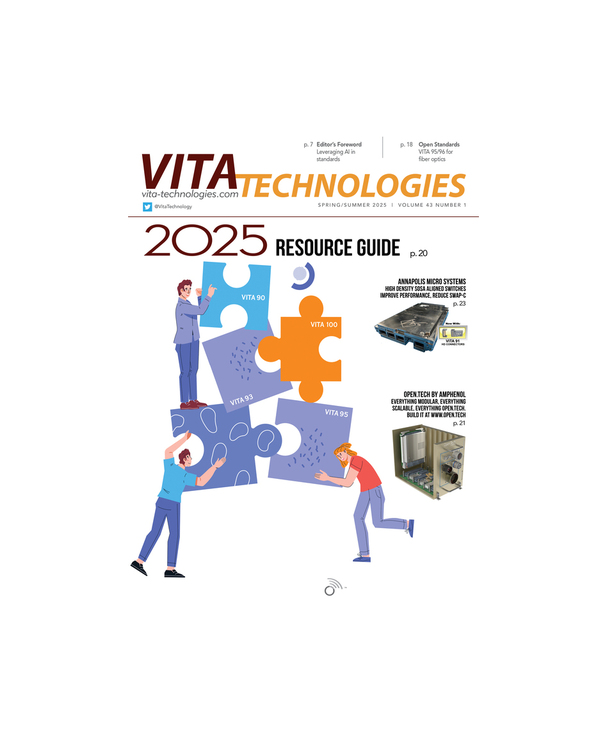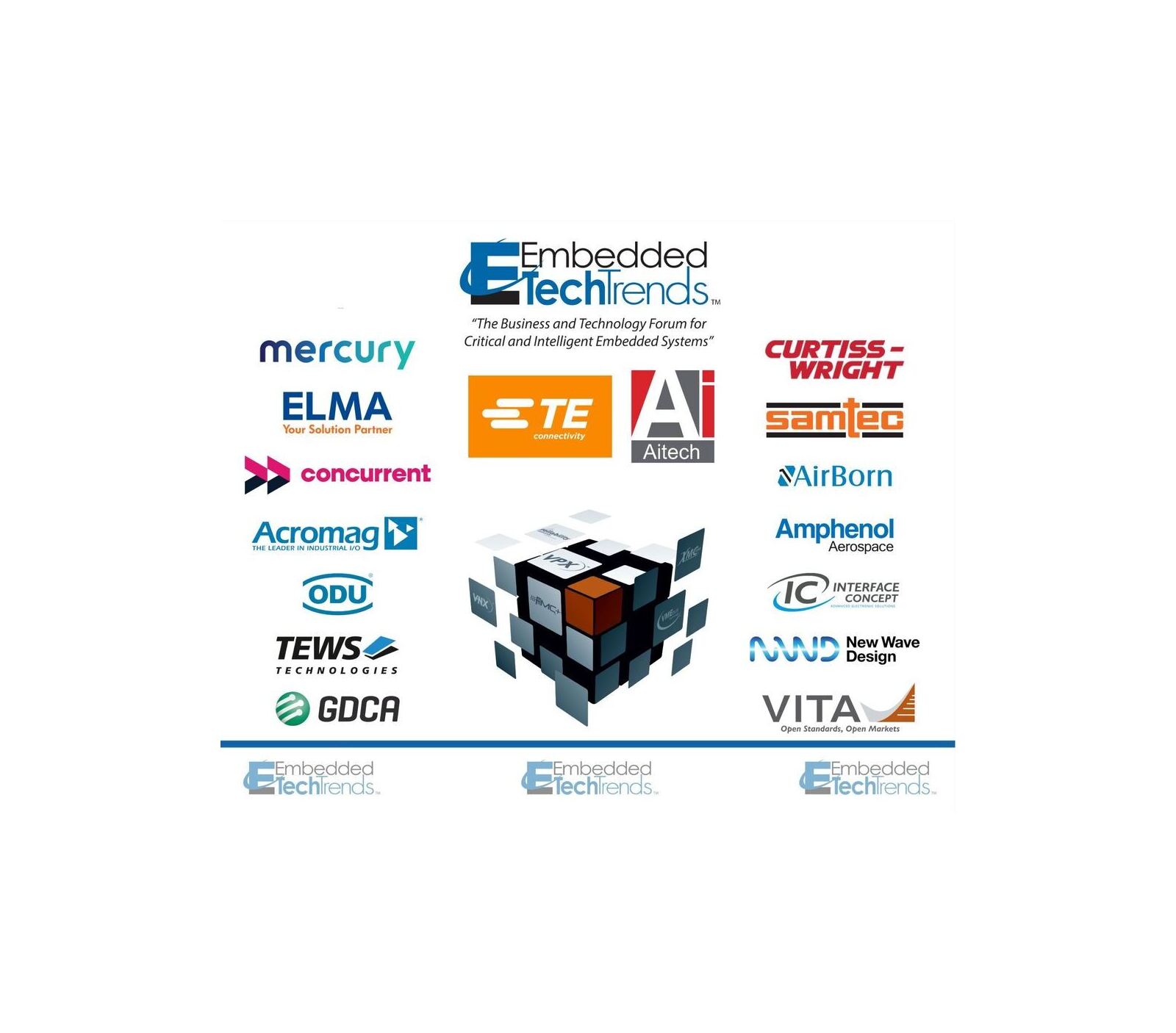VITA is celebrating the 40th anniversary of its origination. VITA initially started in 1982 as the VMEbus Manufacturers Group to support the development of an ecosystem for the new VMEbus specification. Manufacturers developing VMEbus products joined together to educate potential users about the new VMEbus based technologies. In 1985 the VME Manufacturers Group became more organized under the VMEbus International Trade Association (VITA) to accelerate the technical and commercial acceptance of VME.
Work continued on VMEbus under the VITA technical committee as an IEEE standard until 1993 when VITA was granted American National Standards Institute (ANSI) accreditation in June of that year. This opened the doors to innovation and standards related to VMEbus technology. Soon after gaining ANSI accreditation, the VITA Standards Organization (VSO) was formed out of the VITA Technical Committee in the fall of 1993, under Section 5.6 of the VITA Bylaws, to provide VITA members with a formal and accredited method of developing and promoting open technology standards.
One of the first projects of the VSO was the development of a new standard for the VMEbus. That standard was based on the original VMEbus standard written by Motorola, Mostek, and Signetics and placed into the public domain in the early 1980s. Once the VSO completed its work, the proposed standard was submitted under the ANSI standards process and ANSI/VITA 1, VME64, was recognized as an American National Standard (ANS) in 1995, becoming the first VITA standard to receive ANSI approval under the new ANSI/VITA standards development process.
The first non-VMEbus standard to utilize the new ANSI/VITA process was VITA 4 which became the ANSI/VITA 4: IP Module standard, defining the requirements for a business card-sized mezzanine module. The working group was chaired by Jerry Gipper while with the Motorola Computer Group. Kim Rubin, with Greenspring Computers, and the developer of the specification for the original IndustryPacks was the editor. Joe Primeau of Acromag was an active and significant contributor to the editing of the proposed standard.
Since 1995, more than 90 working groups have been approved to begin work on a standard. Included are over 100 sub-working groups established to develop associated dot standards to compliment a primary standard. Managing this standards development activity has required the VSO to evolve its processes while still maintaining its ANSI accreditation.
The VITA way
The procedures to develop standards within the VSO are outlined in the VITA Standards Organization (VSO) Policies and Procedures (www.vita.com/Governance). This process has evolved over the years to meet changing requirements and processes. VITA recently released version 3.1 this past July with major revisions to simplify documenting the standards development process used by the VSO.
VITA is formally accredited by ANSI as a standards developer. This means that VITA follows a rigorous standards development process that adheres to the ANSI Essential Requirements: Due process requirements for American National Standards (www.ansi.org). VITA is required to be audited every five years by ANSI, a very rigorous and detailed procedure, to ensure that ANSI and VITA policies and processes are being followed. Issues are documented and corrective actions must be reviewed by ANSI and implemented before the audit is closed. Passing the audit is required to retain ANSI accreditation. In addition, ANSI issues annual updates to the ANSI Essential Requirements document that must be reviewed and implemented in the VSO Policies and Procedures as necessary to remain accredited.
The development of a standard starts within the VSO in either a study group or a working group and moves through two distinct phases. Development of the proposed standard is conducted during Phase 1; Phase 2 details the process for completing an approval ballot. Before entering Phase 2, the working group chooses one of two tracks. Track 1 leads to a VITA Standard, while Track 2 leads to an ANSI/VITA Standard. The vast majority of proposed standards take the ANSI option.
A new standards project is often launched after a technology or industry problem presentation to the VSO at one of its bi-monthly meetings. Often the presentation leads to a call for a study group or working group to be formed. VITA encourages presentations on technology or issues within the technical scope of the VSO. VITA dropped reference to VMEbus International Trade Association in 2005 to enable broadening of its scope to critical and intelligent embedded computing, with a primary emphasis on backplane-related technologies. This widened focus enables study and working groups to address a broader technical scope.
Phase 1 is where the working group develops the draft documents and where the real work happens. Lively discussions are held, studies and research are conducted, and options discussed. The combined years of experience of the working group participants is invaluable as the working group considers options. Working groups range from small to large in size, depending on the impact of the project. The diligence of the working group is critical to the quality of the final work project.
VITA encourages open and thorough discussions on technical matters. VITA staff monitors the activities and advises as necessary on the process and the technology under discussion. The working group makes final recommendations and decisions. Throughout the process, consensus is encouraged through documented minutes and ballots.
The working group elects a chair and an editor (sometimes the same person in smaller working groups) who lead the process for developing the draft documents. They are required to follow a transparent process to document meetings and develop the draft documents. The working group holds regular meetings with documented minutes for as long as they need to complete a draft for approval. Once the working group has voted to approve the draft documents, it can move forward to Phase 2.
Phase 2 is the public-approval process during which interested parties can review and cast ballots on the proposed standard. A public announcement of a consensus ballot is made by VITA and ANSI so that interested stakeholders can participate in a final ballot if they desire. An interested stakeholder does not have to be a VITA member to participate in balloting during Phase 2.
Comments are often made that standards development organizations are slow, that there are many gates that take long periods of time to complete. The VITA process has minimal time requirements to adhere to during the development of draft standards. The only time constraints center on giving enough time to alert participants to upcoming meetings, to allow adequate time for a review prior to a ballot, and to make calls for public consensus ballots. The working group has full control over how much time they need to develop a draft of a proposed standard for approval. The time needed is usually a function of how complex the proposed standard is, whether or not they had prior work to reference, and how quickly the working group can develop consensus. In addition, the amount of time available to devote to the work is a direct influence on the total time. For most of the working group members, standards development is a secondary job. Phase 1 can take months to years to complete, while Phase 2 can be weeks to months, depending on comment resolution after balloting. In short, the process is not a bottleneck, but rather the effort of the working group.
Standards: the details
A study group may be formed by any VSO member that wishes to investigate the need and to ascertain the interest in developing a standard. The VSO member requesting recognition of the study group is designated the chair of the study group. Membership in the study group is open to any VSO member. The study group chair is responsible for scheduling meetings, soliciting members, keeping minutes of meetings, and reporting activities to the VSO Chair.
A study group can move to working group status by meeting working group formation criteria. A study group disbands if interest in developing a standard related to the study group effort was not achieved within a period deemed reasonable by the VSO membership.
Forming a study group is NOT a prerequisite for forming a working group. A standards activity can begin directly in a working group if the formation criteria are met.
The development of a draft proposed standard takes place in a working group. Three (or more) organizations which are VITA corporate members (regular, senior, or sponsor) may form a working group to carry out the development of a specific standard. Working groups achieve official VSO recognition by meeting the following criteria:
- The development of the standard shall be proposed by three (or more) organizations that are VITA members and wish to sponsor the development of the standard.
- The scope of the proposed standard shall fall within the technical scope of the VSO.
- The sponsors shall notify the VSO Chair of their intentions to form a working group and must submit a document with the purpose, scope, and an outline for the proposed standard.
To maintain formal working group status, the working group must continue to have at least three sponsors that are VITA corporate member companies in good standing and show forward progress in the development of the standard. If the number of sponsors falls below three, then the remaining sponsor(s) may recruit new sponsor(s), may return to study group status, or may disband the working group. A working group is considered official once ANSI has been properly notified by VITA.
VITA has no other limitations on the formation of a study or working group. No business case, industry studies, or other substantiating materials are needed to form a study or working group. VITA advocates that “Open Standards, Open Markets.” In other words, the market will decide how acceptable any given standard will become, not a VITA steering committee. VITA is relatively unique in this aspect in the critical embedded and intelligent computing industry.
Working Group officers
Working groups have a chair and a draft editor, sometimes the same individual on smaller projects. Working group officers are initially appointed by the sponsor organizations, but after two meetings, the working group may hold elections to either reaffirm or elect new officers.
The working group chair is initially appointed by the sponsor organizations and is responsible for the following:
· Soliciting membership for the working group.
· Maintaining a working group membership list.
· Scheduling meetings.
· Leading working group meetings.
· Keep meeting minutes unless the working group has a secretary.
· Reporting development status to the VSO Chair.
· Completing development in a timely manner.
· Submitting a draft for one or more working group ballots.
Working Group Membership: Any employee of or a consultant to a VITA member company or VITA Distinguished Fellow may be a member of a working group. To become a member of a working group, the interested individual formally registers with the chair of the working group committee. Working groups have three levels of participation: sponsor, participant, and observer. Sponsors make a formal commitment to support the standards activity and put forth extra effort to achieve standardization. Participants attend meetings on a regular basis and are expected to cast votes on all working group ballots and any other committee matters. Observers may attend meetings and may vote in ballots.
Working Group Meetings: VITA allows for in-person and virtual meetings as frequently as desired. They may be held at standing VSO meetings or at other times as required. The date, time, and place for in-person must be announced to the working group members 15 days or more in advance, or 48 hours or more in advance for virtual meetings. Most study group and working group meetings are held virtually, with the exception of those held during the bimonthly VSO meetings.
At the start of each meeting, it is required that the chair advises the attendees of the VSO patent, antitrust, ITAR, and code of conduct policy statements. Meeting minutes must be reviewed, approved, and posted for each meeting.
Disclosure of patents
VITA takes patents related to a proposed standard very seriously. VITA broke new ground in the area of disclosure and licensing of patents in standards, becoming the first standards developer in the world to receive guidance for “ex ante” procedures from any legal authority. VITA requires essential patents related to an activity to be disclosed at the start of each working group meeting. An “essential” claim means any claim the use of which is necessary to create a compliant implementation and for which there is no technically and commercially feasible noninfringing alternative. The patent policy is included as part of the VSO Policies and Procedures. Patents filed as part of any standard require a disclosure, which is posted on the VITA website along with fair, reasonable and non-discriminatory (FRAND) terms (www.vita.com/Essential-Patents).
The policy has significant impact in two areas: The first is the change from a voluntary system to a mandatory system of disclosing of essential patents and patent applications. The second area of impact is the Fair, Reasonable, And Non-Discriminatory (FRAND) disclosure of maximum fees or royalties and the most restrictive terms for licenses to technology essential to implementation of a standard that is in development by a working group. Members to newly formed working groups have 60 days to disclose essential patents or patent applications and license terms, while members in existing working groups have 30 days.
The objective of this policy is to eliminate patent ambush. VSO working groups are expected to make sound technical and business decisions. Patent ambushes can delay or undermine the acceptance of new standards.
Working Group balloting
Consensus is key to the open aspect of the development of standards within VITA, Consensus at the working group level is achieved through a web-based balloting process. Balloters during Phase 1 consist of the sponsors, participants, and observers of the working group. Ballots can be anywhere from immediate to 28 days depending on the material to be reviewed. The length of the ballot period shall be proposed by the working group chair with majority agreement of the working group. The working group chair may extend the ballot period up to an additional 14 days in order to allow more time for voting upon request of any of the working group members.
The working group chair shall review all working group ballots with the working group and shall attempt to resolve the NEGATIVE ballots and all comments. The results of working group ballots shall be reported to the VSO Chair. No specific number of working group ballots is required. However, most draft proposed standards require more than one ballot before the draft is completed.
Either a working group ballot or a recirculation of a working group ballot is required when one or more substantive changes are made to a draft. A substantive change is any change which affects compliance with the draft. If a substantive change has been made to the draft, it is the responsibility of the chair of the working group to decide between a new, full working group ballot or a re-circulation ballot.
Phase 2 – Approval Ballot
Standards development takes place in one of two tracks during Phase 2 as decided by the working group during Phase 1. Track 1 becomes a VITA standard, with Track 2 moving to become an ANSI/VITA standard. Openness is emphasized during Phase 2 as a broader approval audience is pulled into the process.
Track 1: To be recognized as a standalone VITA standard, the draft proposed standard must pass a 75/75 VSO ballot. At least 75% of the ballots must be returned and 75% of the returned ballots must be affirmative. The VSO ballot is opened to working group members and to any other VSO members who register to vote. Once the ballot is completed and if the 75/75 criteria is met, the draft proposed standard shall be considered a VITA standard. Very few standards take this track to a standalone VITA standard.
Track 2: The result of Track 2 is an American National Standard/VITA Standard. Once a project has successfully completed the VSO process, the working group responsible for the project may decide to work toward ANSI recognition. Openness is reinforced through coordination of standards efforts with other groups.
Notification of standards development and coordination is key to building a public consensus body. Timely and adequate notice of standards development activity are announced by ANSI and VITA to provide a meaningful opportunity for participation, debate, and deliberation by all directly and materially interested parties in a fair and equitable manner. VITA posts these notices through ANSI, VITA, social media, and relative publications and their websites.
Typical life cycle of a VITA standard
Maintenance of published standards is closely monitored by both ANSI and VITA. A rigorous process for maintenance is followed and audited. An approved standard has several maintenance options; revision, reaffirmation with no changes, and stabilized maintenance are the most common options. Revisions and reaffirmations typically happen in the first five to ten years. Stabilized maintenance (revisions no longer made) occurs in the following 10 to 20 years or more. VITA can notify anyone who has downloaded an approved and published version of a standard from VITA if the status changes.
The typical life cycle for a standard, once approved, is to experience one or two revision/reaffirmation cycles of five years maximum each cycle. A standard often goes to stabilized maintenance for up to 10 years, with an option to extend an additional stabilized maintenance cycle of up to 10 years. At the end of each stabilized maintenance cycle, the standard is reviewed for withdrawal as an ANSI National Standard and either retained as a VITA stabilized maintenance standard or archived.
30 years and beyond
VITA is coming up on thirty years since it first gained ANSI accreditation in 1993. Over the years, VITA has become recognized as an industry leader in standards and ecosystem development. Continued work to improve all the VITA processes makes VITA a leading choice as a developer of key industry standards for the critical and intelligent embedded computing industry. The members of VITA are firmly dedicated to this continued leadership.
Authors: Jerry Gipper, VITA Marketing Director; Dean Holman, VITA Executive Director; Jing Kwok, VITA Technical Director










